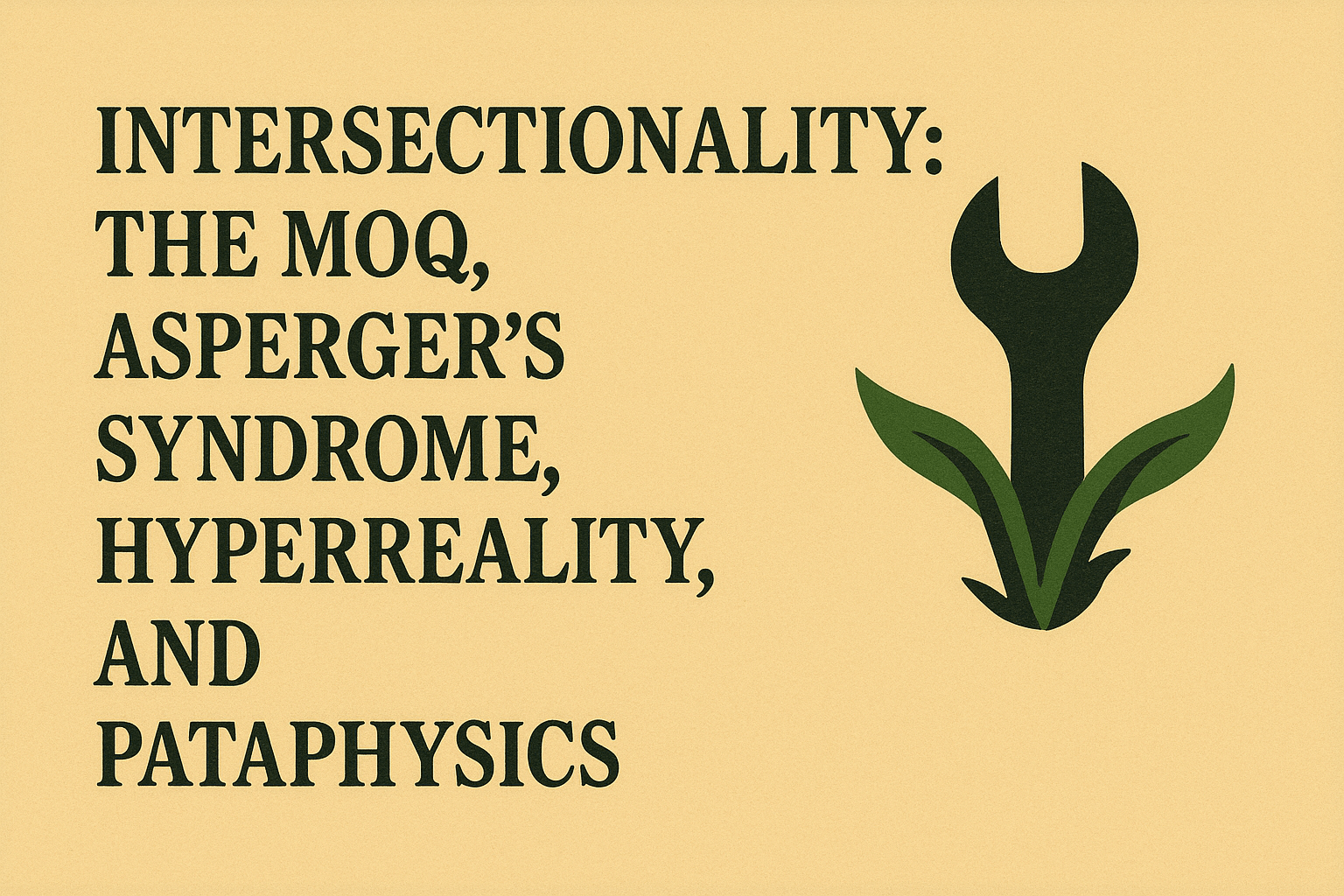An article exploring the intersections of Robert Pirsig’s Metaphysics of Quality (MOQ), Asperger’s Syndrome, concepts of symbolism in Jean Baudrillard’s Hyperreality, and Alfred Jarry’s Pataphysics.
In the realm of philosophical inquiry, certain concepts and frameworks often intersect in intriguing ways, offering new insights and perspectives. This article explores the intersections of Robert Pirsig’s Metaphysics of Quality (MoQ), Asperger’s Syndrome, the concept of hyperreality, and Alfred Jarry’s Pataphysics. By examining these intersections, we can gain a deeper understanding of how these seemingly disparate ideas converge to provide a richer view of human experience and reality.
Robert Pirsig’s Metaphysics of Quality (MoQ)
Robert M. Pirsig’s Metaphysics of Quality is a philosophical framework that places quality at the core of reality. In his seminal works, Zen and the Art of Motorcycle Maintenance and Lila: An Inquiry into Morals, Pirsig presents quality as the fundamental essence that transcends the traditional subject-object dichotomy. He divides quality into two categories: static quality, which encompasses structured, stable aspects of life, and dynamic quality, which represents the innovative, changing forces of existence.
Asperger’s Syndrome
Asperger’s Syndrome, a condition on the autism spectrum, is characterized by difficulties in social interaction, repetitive behaviors, and a deep focus on specific interests. Individuals with Asperger’s often exhibit unique ways of perceiving and interacting with the world, which can provide distinctive insights into the nature of quality and reality.
- Attention to Detail: People with Asperger’s Syndrome often possess an extraordinary attention to detail and a capacity for deep focus. This characteristic aligns with Pirsig’s emphasis on technical precision and the importance of quality in craftsmanship. Their meticulous approach can be seen as an embodiment of static quality, where structure and order are paramount.
- Unique Perception: The unique ways in which individuals with Asperger’s perceive the world can challenge conventional notions of quality. Their experiences highlight the subjective nature of quality and the importance of diverse perspectives in understanding reality.
Hyperreality
Hyperreality, a concept introduced by the philosopher Jean Baudrillard, refers to the condition in which reality is indistinguishable from simulations of reality. In a hyperreal world, symbols and representations become more real than the reality they signify, leading to a blurring of boundaries between the real and the imaginary.
- Symbolism and Quality: Hyperreality challenges the MoQ by emphasizing the role of symbols and representations in shaping our perception of quality. In a hyperreal world, the distinction between static and dynamic quality becomes complex, as simulations and representations influence our understanding of what is real and valuable.
- Perception and Reality: The concept of hyperreality underscores the subjective nature of quality and reality. It aligns with Pirsig’s idea that quality is a fundamental reality that transcends conventional distinctions, suggesting that our perception of quality is deeply intertwined with the symbols and representations we encounter.
Alfred Jarry’s Pataphysics
Pataphysics, a pseudo-scientific philosophy invented by French writer Alfred Jarry, explores the imaginary and the absurd. It is described as the “science of imaginary solutions” and examines what lies beyond the realm of metaphysics.
- Imaginary Solutions and Dynamic Quality: Pataphysics aligns with Pirsig’s concept of dynamic quality, which values innovation and creativity. By embracing the absurd and the imaginary, pataphysics encourages a break from conventional thinking and opens up new possibilities for understanding quality.
- Challenging Conventional Reality: Pataphysics, like hyperreality, challenges conventional notions of reality and quality. It underscores the importance of imagination and creativity in shaping our understanding of the world, resonating with Pirsig’s emphasis on dynamic quality.
Intersecting Insights
By exploring the intersections of the MoQ, Asperger’s Syndrome, hyperreality, and pataphysics, we can uncover new perspectives on quality and reality.
- Diverse Perspectives on Quality: The unique perceptions of individuals with Asperger’s, the symbolic nature of hyperreality, and the imaginative solutions of pataphysics all highlight the multifaceted nature of quality. These perspectives encourage a broader, more inclusive understanding of quality that transcends traditional boundaries.
- Integration of Static and Dynamic Quality: The meticulous attention to detail associated with Asperger’s Syndrome exemplifies static quality, while the innovative and imaginative aspects of hyperreality and pataphysics embody dynamic quality. Integrating these aspects can lead to a more balanced and holistic understanding of quality.
- Challenging Conventional Reality: Hyperreality and pataphysics challenge conventional notions of reality, resonating with Pirsig’s critique of traditional rationality. By questioning the boundaries between reality and representation, we can deepen our understanding of the complex interplay between quality, perception, and reality.
Conclusion
The intersections of Robert Pirsig’s Metaphysics of Quality, Asperger’s Syndrome, hyperreality, and Alfred Jarry’s pataphysics provide a rich tapestry of insights into the nature of quality and reality. By integrating the unique perceptions of individuals with Asperger’s, the symbolic complexities of hyperreality, and the imaginative solutions of pataphysics, we can achieve a more nuanced and comprehensive understanding of quality. These intersections challenge us to think beyond conventional boundaries and embrace a more dynamic, inclusive view of reality, ultimately enriching our appreciation of the intricate and multifaceted nature of quality in life.
